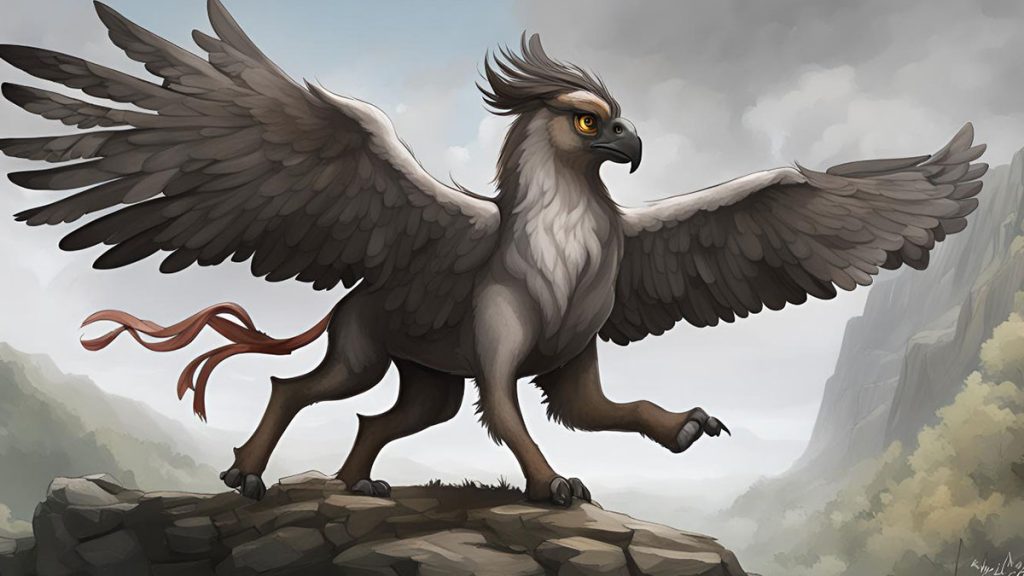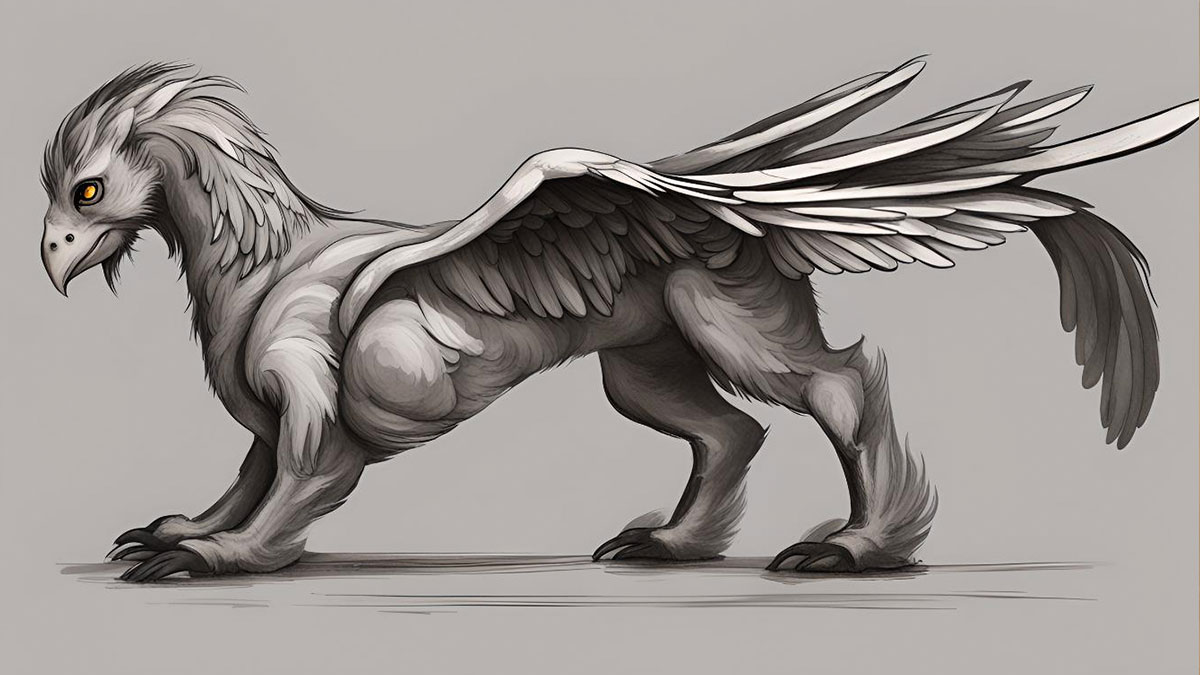The hippogriff is a mythical creature often described as a cross between a griffin and a horse. A griffin has the head and torso of an eagle but the body of a lion; however, a hippogriff has the body of a horse and the head of an eagle.
Although the hippogriff is probably best known today as one of the magical beasts from the Harry Potter novel and movie series, its origins go back to at least the beginning of the Renaissance in the 16th century. The griffin, from which the hippogriff came, has a much longer history and is thought to be up to 5,000 years old.
Hippogriff is half eagle-half horse and has magical powers
Griffins liked to prey on horses and occasionally mated with mares, which led to hippogriff offspring. The hippogriffs have a head, beak, neck, torso, and facial features of an eagle. They also have eagle wings sprouting from their shoulders, talon claws on their front legs, and feathers covering the front part of their body. But the rest of their body is that of a regular horse.
The hippogriff is a very large animal that can carry humans on its back. It can be much larger than a horse, standing over 12 feet high. The creature has superpowers, such as being able to travel at lightning speed and colossal distances, even as far as the moon.
The creature is thought to have originated from the imagination of Ludovico Ariosto (1474-1573), a 16th-century Italian poet who wrote about a “griffin-horse” in his epic romance and adventure poem Orlando Furioso. The poem tells the story of Orlando, a Christian knight from an older time who has numerous adventures set against a backdrop of a war between Christians and Saracens. The poem combines tragedy and humor with realism and fantasy and features other strange beasts besides the hippogriff.

In Orlando Furioso (Orlando Enraged), the hippogriff is used by a selection of the main characters to travel various distances, often to rescue a young woman in distress. The hippogriff is owned by a wizard known as Atlante. Part of the poem tells the story of a Saracen knight, Ruggiero, who fell in love with a female Christian warrior known as Bradamante. At one point, Ruggiero uses the hippogriff to rescue his beloved. This moment has been captured multiple times in artwork. Another plotline involves an English knight, Astolfo, riding the hippogriff looking for Orlando’s wits.
Hippogriff first recorded in print in 16th century
Ariosto first published part of the poem in 1516, and since then, his work has inspired numerous translations and adaptations. Many English translations refer to the hippogriff as a “griffin-horse” or a “gryphon.” The word itself comes from the Greek for horse, “hippos,” and the Italian for griffin, “grifo.”
An English version of Ariosto’s poem, translated by John Hoole in 1785, introduced the hippogriff as follows:
“A griffin and a mare the mingled breed
Compos’d; and like his fire his feet before,
His head, his feathers, and his wings he wore;
(In all the reft his mother-mare was shown)
And by the name of griffin-horfe was known.
Such, though but rarely, in thofe hills appear,
Beyond where ocean feels the freezing year.
Thence had the enchanter drawn him by his fkill,
And made him foon obedient to his will;
Taught him the faddle and the reins to wear,
And o’er the earth and feas his mafter bear.”
Another more modern translation by William Stewart Rose from 1995 describes the hippogriff as follows:
“That hippogryph, huge fowl, and strange to sight,
Bears off the warrior with such rapid wing,
He would have distanced, in his airy flight,
The thunder bearing bird of Aether’s king:
Nor other living creature soars such height,
Him in his mighty swiftness equalling.
I scarce believe that bolt, or lightning flies,
Or darts more swiftly from the parted skies.XIX
When the huge bird his pinions long had plied,
In a straight line, without one stoop or bend,
He, tired of air, with sweeping wheel and wide,
Began upon an island to descend;
Like that fair region, whither, long unspied
Of him, her wayward mood did long offend,
Whilom in vain, through strange and secret sluice,
Passed under sea the Virgin Arethuse.”
Hippogriff has become regular feature of folklore
Since Orlando Furioso, the hippogriff became a regular feature in medieval European myths and folklore. In the next few hundred years, it appeared numerous times in literature, including in such diverse works as The Castle of Crossed Destinies by Italo Calvino and Salman Rushdie’s The Enchantress of Florence. In 1862, Thomas Bulfinch, an expert in medieval mythology, released his third volume of Legends of Charlemagne, or Romance of the Middle Ages, which included the following description of Bradmante’s rescue:
“The enchanter delayed not to present himself, mounted on his winged horse. Bradamante was struck with surprise mixed with joy when she saw that this person, described as so formidable, bore no lance nor club, nor any other deadly weapon. He had only on his arm a buckler, covered with a cloth, and in his hand an open book. As to the winged horse, there was no enchantment about him. He was a natural animal, of a species which exists in the Ri phæan mountains. Like a griffin, he had the head ofan eagle, claws armed with talons, and wings covered with feathers, the rest of his body being that of a horse. This strange animal is called a Hippogriff.”
Hippogriff creature Buckbeat appeared in Harry Potter series
The hippogriff experienced a more modern revival in popularity after it appeared in JK Rowling’s 1999 novel Harry Potter and the Prisoner of Azkaban and the 2004 movie of the same name. The creature, known as Buckbeat, was considered proud and dangerous but could also show great loyalty and affection.
Buckbeat became an ally of Harry Potter after he was rescued by the boy wizard and his friends when given a death sentence for attacking antagonist Draco Malfoy. Malfoy had unfairly provoked the beast, and the sentence was considered unjust by Potter and his pals.
Rowling introduced the hippogriffs as follows:
“Trotting towards them were a dozen of the most bizarre creatures Harry had ever seen. They had the bodies, hind legs, and tails of horses, but the front legs, wings and heads of … giant eagles, with cruel steel-coloured beaks and large, brilliantly orange eyes. The talons on their front legs were half a foot long and deadly looking.”
Hippogriffs will likely continue to play an important role in myth and folklore for many years to come.
References
Ariosto, Ludovico. “Orlando Furioso.” Originally published in 1516, this edition comes from 1785 and was translated by John Hoole. Accessed June 6, 2024.
Ariosto, Ludovico. “Orlando Furioso.” Translated in 1995 by William Stewart Rose. Accessed June 7, 2024.
Art Gallery of NSW, “Orlando Furioso: Atlante, mounted on the hippogryph, swoops down upon Bradamante,” accessed June 7, 2024.
Bulfinch, Thomas. “Legends of Charlemagne, or Romance of the Middle Ages,” Vol.3, (1862). Pub.: Tilton. Accessed June 7, 2024.
Fairytales and Myths, “Griffin,” accessed June 7, 2024.
Jossa, Dr Stefano. “Ariosto, Harry Potter and Hippogriffs: weaving textual webs,” in the British Academy (March 2016). Accessed June 7, 2024.
Rosen, Brenda. “Hippogriffs,” in The Mythical Creatures Bible, (2009). Pub.: Sterling. Accessed June 6, 2024.
Rowling, JK. Harry Potter and the Prisoner of Azkaban, (1999). Pub.: Bloomsbury.
The Electric Light Company, “Orlando Furioso: Plot summary and best paintings 1,” accessed June 7, 2024.
